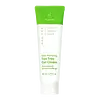What's inside
What's inside
 Key Ingredients
Key Ingredients

 Benefits
Benefits

 Concerns
Concerns

No concerns
 Ingredients Side-by-side
Ingredients Side-by-side

Water
Skin ConditioningSalicylic Acid
MaskingGlycerin
HumectantButylene Glycol
HumectantSodium Polyacryloyldimethyl Taurate
Emulsion StabilisingHydrogenated Polydecene
EmollientTrideceth-10
CleansingPolyacrylate Crosspolymer-6
Emulsion StabilisingPhenoxyethanol
PreservativeEthylhexylglycerin
Skin ConditioningSodium Hydroxide
BufferingCaesalpinia Spinosa Gum
Skin ConditioningBisabolol
MaskingDisodium EDTA
Citric Acid
BufferingHibiscus Sabdariffa Flower Extract
Skin ConditioningMorus Alba Bark Extract
Skin ConditioningCucumis Sativus Seed Extract
Skin ConditioningPlumeria Obtusa Leaf Cell Extract
AntioxidantVaccinium Myrtillus Leaf Extract
AstringentSodium Benzoate
MaskingCinnamomum Cassia Bark Extract
MaskingZingiber Officinale Root Extract
MaskingSanguisorba Officinalis Root Extract
CleansingPropanediol
SolventPrunus Yedoensis Flower Extract
HumectantAloe Barbadensis Leaf Extract
EmollientBioflavonoids
Skin ConditioningBrassica Oleracea Italica Extract
AstringentAgastache Rugosa Extract
Antimicrobial4-Terpineol
MaskingPapain
Skin ConditioningChondrus Crispus Extract
Skin ConditioningSodium Hyaluronate
HumectantWater, Salicylic Acid, Glycerin, Butylene Glycol, Sodium Polyacryloyldimethyl Taurate, Hydrogenated Polydecene, Trideceth-10, Polyacrylate Crosspolymer-6, Phenoxyethanol, Ethylhexylglycerin, Sodium Hydroxide, Caesalpinia Spinosa Gum, Bisabolol, Disodium EDTA, Citric Acid, Hibiscus Sabdariffa Flower Extract, Morus Alba Bark Extract, Cucumis Sativus Seed Extract, Plumeria Obtusa Leaf Cell Extract, Vaccinium Myrtillus Leaf Extract, Sodium Benzoate, Cinnamomum Cassia Bark Extract, Zingiber Officinale Root Extract, Sanguisorba Officinalis Root Extract, Propanediol, Prunus Yedoensis Flower Extract, Aloe Barbadensis Leaf Extract, Bioflavonoids, Brassica Oleracea Italica Extract, Agastache Rugosa Extract, 4-Terpineol, Papain, Chondrus Crispus Extract, Sodium Hyaluronate
Melaleuca Alternifolia Leaf Extract 78.4%
PerfumingGlycerin
HumectantButylene Glycol
Humectant2,3-Butanediol
Humectant1,2-Hexanediol
Skin ConditioningCentella Asiatica Extract
CleansingWater
Skin ConditioningAmmonium Acryloyldimethyltaurate/Vp Copolymer
Squalane
EmollientHydroxyacetophenone
AntioxidantCarbomer
Emulsion StabilisingEthylhexylglycerin
Skin ConditioningPanthenol
Skin ConditioningDipotassium Glycyrrhizate
HumectantTromethamine
BufferingInulin Lauryl Carbamate
Emulsion StabilisingSodium Surfactin
CleansingHouttuynia Cordata Extract
Skin ConditioningCamellia Sinensis Leaf Extract
AntimicrobialBeta-Glucan
Skin ConditioningMadecassoside
AntioxidantAsiaticoside
AntioxidantAsiatic Acid
Skin ConditioningMadecassic Acid
Skin ConditioningMelaleuca Alternifolia Leaf Extract 78.4%, Glycerin, Butylene Glycol, 2,3-Butanediol, 1,2-Hexanediol, Centella Asiatica Extract, Water, Ammonium Acryloyldimethyltaurate/Vp Copolymer, Squalane, Hydroxyacetophenone, Carbomer, Ethylhexylglycerin, Panthenol, Dipotassium Glycyrrhizate, Tromethamine, Inulin Lauryl Carbamate, Sodium Surfactin, Houttuynia Cordata Extract, Camellia Sinensis Leaf Extract, Beta-Glucan, Madecassoside, Asiaticoside, Asiatic Acid, Madecassic Acid
 Reviews
Reviews

Ingredients Explained
These ingredients are found in both products.
Ingredients higher up in an ingredient list are typically present in a larger amount.
Butylene Glycol (or BG) is used within cosmetic products for a few different reasons:
Overall, Butylene Glycol is a safe and well-rounded ingredient that works well with other ingredients.
Though this ingredient works well with most skin types, some people with sensitive skin may experience a reaction such as allergic rashes, closed comedones, or itchiness.
Learn more about Butylene GlycolEthylhexylglycerin (we can't pronounce this either) is commonly used as a preservative and skin softener. It is derived from glyceryl.
You might see Ethylhexylglycerin often paired with other preservatives such as phenoxyethanol. Ethylhexylglycerin has been found to increase the effectiveness of these other preservatives.
Glycerin is already naturally found in your skin. It helps moisturize and protect your skin.
A study from 2016 found glycerin to be more effective as a humectant than AHAs and hyaluronic acid.
As a humectant, it helps the skin stay hydrated by pulling moisture to your skin. The low molecular weight of glycerin allows it to pull moisture into the deeper layers of your skin.
Hydrated skin improves your skin barrier; Your skin barrier helps protect against irritants and bacteria.
Glycerin has also been found to have antimicrobial and antiviral properties. Due to these properties, glycerin is often used in wound and burn treatments.
In cosmetics, glycerin is usually derived from plants such as soybean or palm. However, it can also be sourced from animals, such as tallow or animal fat.
This ingredient is organic, colorless, odorless, and non-toxic.
Glycerin is the name for this ingredient in American English. British English uses Glycerol/Glycerine.
Learn more about GlycerinWater. It's the most common cosmetic ingredient of all. You'll usually see it at the top of ingredient lists, meaning that it makes up the largest part of the product.
So why is it so popular? Water most often acts as a solvent - this means that it helps dissolve other ingredients into the formulation.
You'll also recognize water as that liquid we all need to stay alive. If you see this, drink a glass of water. Stay hydrated!
Learn more about Water